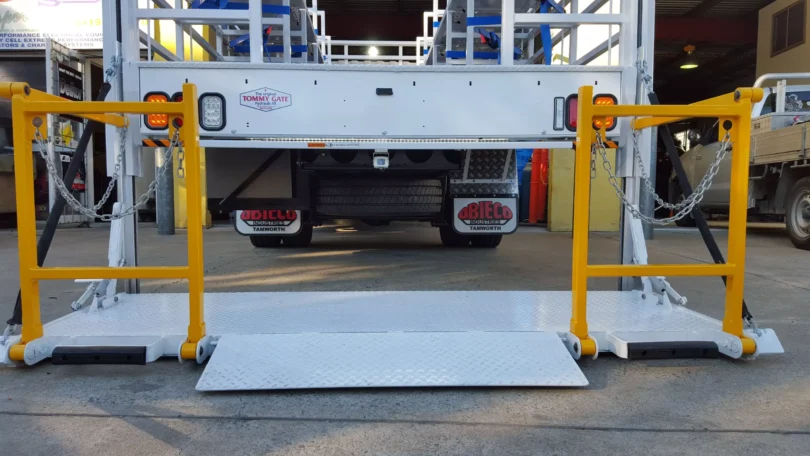 |
Tail-lift deliveries are the most environmentally friendly way to load and sell things when there is no unloading platform or dock. But what are the advantages and disadvantages of the tail-elevate solution? In this article, we will educate you on what tail-elevate lane is relevant and why you will pay more attention to it in the future.
Tail-lift is a platform mounted on the trailer’s door that raises the hundreds between the trailer and the floor level. They are available for vans, trucks for STL / LTL, and FTL hundreds to gain you at many points of the delivery chain. Let us examine the benefits of Tail Lifts delivery and also about https://www.paireytaillifts.co.uk/.
What exactly is a tail lift?

Source: vanrentals.ie
A tail lift is a mechanically driven platform attached to the vehicle. The platform is higher or lowered to achieve a level of relationship with the vehicle body or the ground. With this in mind, bulkier or heavier things may get unloaded safely and without the chance of harm or accident.
What roles does the Tail-lift installation serve?
A concrete foundation with embedded metal parts is required to build such a riser, to which the bottom half of the riser will get linked and function as a counterbalance. Another embedded element will get located above the loading door, where the top portion of the elevator will be attached. It should be mentioned that the wall on which the top, built-in element gets mounted must be of good quality and capable of bearing the weight. There is a tensile load when the hoist is functioning.
What variations of tail lift exist?

Source: maxilift.com.au
Column Lifts
Smaller vehicles with less ground clearance work better with column lifts. The platform is vertically positioned across the vehicle’s body and is mounted in the back using an H-frame. While the external platform can get manually raised and closed, the lift itself is chain-linked to a hydraulic power pack.
Cantilever Lifts
Cantilever lifts are mounted on the chassis and fold up to make up a portion of the rear. They are typically utilised for heavy loads inappropriate for Smaller column lifts. Cantilever lifts are hydraulic, and the operational cycle time is relatively slow. Consequently, they can raise more weight than column lifts.
Tuckaway Lifts
Tuckaway lifts have a foldable split platform and are also chassis mounted. Unlike a column lift or cantilever, it does not obstruct access to the back because it requires less storage space.
The lift is less likely to sustain damage because it is beneath the back – they need higher ground clearance.
Parallel Arm
Parallel Arm lifts get frequently installed on the bodies of pickup trucks and service trucks, and they support lower lifting capacities. The lifting platform gets guided away from the liftgate mainframe by the parallel “arms” attached to its sides. Two hydraulic cylinders that deliver force to the lifting platform get used in some Parallel Arm designs, and a single hydraulic cylinder may also use a cable-pulley system.
Railgate
Although they provide less lifting capacity overall, railgate lifts are similar in design to column lifts. The “outrails” installed directly to the vehicle body and used to guide the liftgate platform give railgate its name. Platforms on tailgates are Larger than those on parallel arm lifts, set at a 90° angle from the outrails like column lifts, and rise vertically.
Slider
Like tuckunders, slider lift designs function by folding and storing directly beneath the vehicle bed. Additionally, slider designs include elevating platforms that “slide” out from under the car bed (instead of lowering and unfolding). The lifting capacity of slider lift designs is among the highest available in hydraulic lifts.
Know the advantages of tail-lift:

Source: palfinger.com
Here you find The benefits of Tail Lifts are:
Reduce Handling and Damage from Use:
Less cargo handling is a significant advantage of employing a tail lift trailer. Surcharges and off-site discharges are eliminated, lowering handling and the total cost of ownership. Furthermore, less handling instantly translates into fewer possible bugs, truck damage, theft, and many others.
The following products are ideal for loading onto a high vehicle:
Loading large objects onto a high truck or vehicle might be problematic. Tail lifts, on the other hand, have the benefit of height and may thus be employed anytime there is a massive difference in measurement between the loading area and the vehicle’s loading ramp. The relative difference of tail lifts assists in loading things at any height, minimising the work required.
Savings in miles:
A tail lift on a trailer eliminates the need for products to pass through a hub at the port. Instead, merchandise is carried from point A to point B with no added miles.
Material Handling and Loading:
Material handling techniques entail dangers to workers, equipment, and commodities, making it critical for many industrial businesses to establish a method of managing such loads. When considering outdoor loading and short-hauls in these instances, tail lifts provide an appropriate alternative for ensuring worker safety requirements during operations.
More efficient distribution models:
Ultimately, employing a platform lift saves time. Although tail-lift deliveries take longer than standard deliveries, they help the supply chain.
How to safely use a tail lift

Source: marshallfleetsolutions.co.uk
Activate the isolator switch.
Turning on and off the tail lift requires the isolation switch. You’ll find this switch in the cab to the right of the steering wheel.
Platform lowered
Press the button adjacent to the downward arrow using the outside control found on the back of the car. Continue pressing the button once the platform has lowered by around 30 cm.
Fold the platform out.
Open the bottom loading platform by lifting the catch. The catch gets located on the platform’s left side.
Raise the top hatch
Carefully raise the top hatch until it fixes in place using the lever on the top left-hand side.
Think about the weight of your load.
There is a maximum weight that all tail lifts can support. Remember to add yourself to whatever you get lifting if you are also standing on it. Achieving more than this could put you in danger, so refrain from doing so.
Useful information
- The tail lift can support a maximum weight of 500 kg.
- The tail lift will beep if it is not closed.
- The tail lift operates without the ignition getting turned on.




